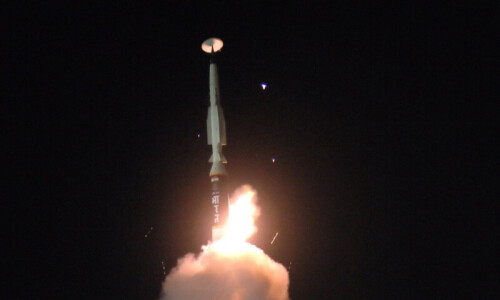SOUTH Asia experienced two crises with the advent of covert nuclear weapon capabilities and three more after India and Pakistan carried out underground tests of nuclear weapon designs.
The first nuclear-tinged crisis in South Asia, sparked by Operation Brasstacks in 1986-87, was initiated by decisions made in India. The four crises that followed can all be traced to decisions made in Pakistan: in 1990 over Kashmir; in 1999, when Northern Light Infantry troops occupied the heights across the Kashmir divide, sparking a limited war; in 2001-2002, during the ‘Twin Peaks’ crisis initiated by an attack by militants based in Pakistan on India’s parliament building; and in 2008, when Pakistani-based militants struck iconic targets in Mumbai.
For the 1990 and Kargil crises, the role played by Pakistan’s military and security apparatus was not plausibly deniable. The involvement and foreknowledge of the highest levels of Pakistan’s military establishment have been harder to establish for the Twin Peaks and Mumbai crises. What can be said with confidence is that the authorities in Pakistan did not take serious preventative actions before mass casualty attacks occurred on Indian soil by perpetrators trained, equipped and based in Pakistan.
It is also clear that the authorities in Pakistan have either been unable or unwilling to take significant actions against those who planned mass casualty attacks. There have been temporary and polite house detentions, lingering court cases and no convictions of leading figures. It is similarly hard for Indian authorities to secure convictions in highly politicised prosecutions.
After the mass casualty attacks directed against targets in New Delhi and Mumbai, very different Indian coalition governments came to the same conclusion: that the benefits of striking back against Pakistan would likely be modest and the risks would likely be great.
Foremost among those risks was the possibility of uncontrolled escalation. Indian leaders weighed other risks, as well. Counter-attacks on Pakistani targets could have prompted changes in civil-military relations and in Pakistani domestic politics that would not have been to India’s benefit.
There would also have been very negative repercussions for US and allied forces in Afghanistan that would not have served Indian interests. Other calculations contributed to uncommon Indian restraint, including the undiminished hopes of Indian prime ministers to eventually normalise relations with Pakistan.
Nuclear weapons have played a significant part in these crises. They have emboldened Pakistani decision-makers to take crisis-generating risks. With each succeeding crisis and with India’s growing conventional capabilities, Pakistan’s reliance on nuclear weapons for deterrence has grown. It is clear that Pakistan’s military leadership wants India to think long and hard about conventional strikes in light of Pakistan’s growing nuclear capabilities.
Crises can also arise due to the actions of extremist Hindu groups that seek to derail efforts to normalise India-Pakistan relations or to ‘pay back’ Muslims for attacks by groups with ties to Pakistan’s intelligence services. Attacks similar to the 2007 Samjhauta train bombing may reoccur. Because these attacks are usually carried out by Indians on Indian soil, they do not have severe escalatory potential.
In contrast, mass casualty attacks on Indian soil by Muslim extremists based in Pakistan have far more potential to prompt sustained lapses in diplomacy as well as severe crises. Since 2002, these attacks have been targeted at major Indian cities far away from Jammu and Kashmir.
If and when the next such attack happens, Washington will resort to a familiar crisis management playbook developed and refined after the last two crises. How effective this playbook will be depends upon what outcome the Indian government wants and is willing to accept.
The risk-benefit calculus as perceived from New Delhi may be little different from that of the last two crises because Pakistan’s domestic political situation and civil-military relations have deteriorated with each successive crisis. But domestic political compulsions in India might trump these considerations, overriding concerns about uncontrolled escalation, as well.
Whether or not India strikes back, Pakistan will be the big loser in the event of another mass casualty attack on Indian soil that can be traced back to Pakistan. After each crisis, India rebounds and India’s economy resumes its high growth rate. Pakistan doesn’t rebound after mass casualty attacks. Its economy becomes increasingly burdened and its domestic political environment deteriorates.
After each crisis sparked by a mass casualty attack on Indian soil linked to Pakistani nationals, US-India relations improve, including bilateral military relations. After each crisis, US-Pakistani relations become more problematic.
US crisis management becomes harder with every crisis. The ‘deliverables’ expected of Washington’s crisis managers are increasingly suspect. Promises that have been extracted from Pakistan’s leaders in past crises have turned out to have a limited warranty. Indian governments have had little faith in these promises, but accepted them because New Delhi was disinclined to respond militarily. The buckets that Washington’s crisis managers have drawn from this well may now be empty.
Another difficulty of US crisis management is that the United States is perceived in Pakistan as less of an honest broker because of Washington’s growing closeness to New Delhi. Nonetheless, Pakistani leaders have no alternative, credible crisis manager.
The next crisis in South Asia will play out in the context of a greater disparity in conventional capability in India’s favour and a greater disparity in nuclear capability in Pakistan’s favour — hardly a good equation for deterrence and crisis stability. Crisis prevention is therefore crucial.
India’s intelligence and security services will have failed in their duties if and when another Samjhauta Express-type attack occurs. Similarly, a highly capable chief of army staff in Pakistan should have the means to know in advance when major operations with a high escalatory potential are being planned, trained for and equipped on Pakistani soil. Given the negative consequences of such an attack for Pakistan, an army chief that fails to stop it ill serves Pakistan’s national security and economic interests.
The writer is the co-founder of the Stimson Centre in Washington.











































Dear visitor, the comments section is undergoing an overhaul and will return soon.